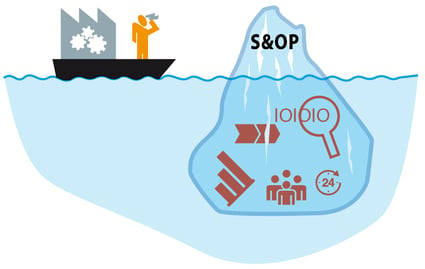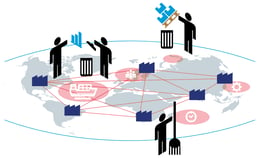5 Critical Stats About S&OP
Jesse Kelber - October 03, 2019

Do you check the weather report before leaving for work? What about for the upcoming weekend, to be sure your plans for a hike won’t be washed out? OK, how about paying attention to the long-range outlook, like how much snow is expected next winter and how that will affect the prospects of a drought the following summer? Weather forecasting shares many aspects with demand forecasting for your supply chain. You need to be able to look at the near term—say the upcoming few weeks—as well as the next 3-18 months and beyond. This is equivalent to checking the weather for tomorrow, the next two weekends, and the upcoming few seasons. If you want the whole picture, you need to gather as much information as you can on all three time frames.
And just like each newspaper, TV station meteorologist, and weather website will all have different forecasts, everyone seems to have their own opinion on the efficacy of demand forecasting tools, techniques, and solutions. That said, when it comes to mid-range (say 3-18 months) demand forecasting and planning, sales and operations planning (S&OP) is the clear winner. We’ve collected 5 statistics that back up this assertion, presented today to help you understand the power of this forecasting methodology and to help you decide if implementing an S&OP process is the right move for your organization.
1. 63% of Planners Say Data Access is Still a Problem
We all understand the power of data by now, right? This statistic is the percentage of planners (who responded to a recent survey) that say they have trouble getting their hands on the data they need to plan and forecast accurately. The issues can stem from a lack of access to the data, or a lack of existing data, period. If you’re considering implementing S&OP, or if you have processes in place but aren’t seeing the results you know you should be, dig into your data. Are you collecting readings from sensors on the production line? How about from your trucks in the field? Where is that data stored, and importantly, do your planners have access to that location? If not, you know where to start.
2. 70% Have Adopted S&OP Practices
The Hackett Group recently surveyed planners and other supply chain decision makers about their forecasting and planning processes. The specific degree of adoption varies in this response group, but the minimum requirement is for the company to have a process in place that spans departments and takes as its goal the balancing of production and sales quantities with the intent of creating more accurate forecasts. That’s better than ⅔ of companies using the methodologies of S&OP to improve their forecasting and planning. These companies are likely to see reduced inventory costs, improved ROI on the Industry 4.0 technologies they deploy, and more robust data on which to base future activities.
3. 80% Say They Have Tight Coordination Between Sales & Operations Outside of S&OP
While it wasn’t determined in this study which came first, they did find a correlation between organizations with strong S&OP processes and good communication and coordination between sales and operations across the board. We can see the argument for it working either way, good communication leading to strong S&OP, or S&OP being the catalyst for improving communications in other areas of the business. The same can go for other departments involved in S&OP, sales & IT, operations & finance, etc. Whichever direction the communication flows, it is crucial to success in this arena, relying as it does on data from multiple departments, analysis conducted across the company, and impacting the entire value chain’s activities in the coming months.
4. 57% Incorporate Data Analytics in Their S&OP Process
Speaking of analysis of S&OP data, more than ½ of the planners surveyed here say they’re already using advanced analytics to pull deeper insights out of the data they’re generating and to fine-tune their forecasting even more. Much of this analysis can be done using what’s called a digital twin. This is essentially a clone of your supply chain that exists as a virtual entity, mirroring the steps and processes involved from raw material delivery to the customer’s doorstep. Using your twin to analyze the data coming out of your real-world S&OP process gives the advantage of seeing the potential outcomes without affecting anything in reality, testing tweaks and making adjustments to optimize the process.
5. 72% are Happy with the Outcome of Their S&OP Processes
Any business process that can produce a “happiness” rating this high is something to pay attention to. However, the same survey found that 66% of respondents also said they want to take steps to improve those very same S&OP processes. What this tells us is that while S&OP has come a long way in its nearly 3 decades of existence as a methodology, there will always be ways to iterate and adjust for even better outcomes. This survey found something else we find fascinating, which is that having a dedicated IT infrastructure in place to manage S&OP was not a deciding factor in the satisfaction a company showed. That means that whether they use an S&OP specific solution or a module in their supply chain management tool, it’s the S&OP process itself that these organizations are happy with.
Now, what are the takeaways and why exactly are these statistics so critical? This collection of statistics was chosen to display existing adoption of S&OP practices, current levels of satisfaction with those processes involved, and to highlight that despite all that there is room for further improvement. No matter where you fall on the S&OP spectrum, from a full dedicated team all the way to nothing at all, your company and your supply chain can reap the benefits of implementing a structured sales and operations planning solution. Our key takeaway, if we had to pick just one, is that there is power in the mid-range planning capabilities that S&OP enables. And that means it’s worth taking a hard look at how you might be able to start incorporating it into your planning workflow.
If you want to learn more get your Guide to Sales & Operations Planning
In this Guide you will learn:
-
Why a S&OP Process is important
-
How a S&OP System can be flexible and quickly implemented
-
Central tasks of a S&OP System
-
The key to more productivity
LATEST POSTS
- Understand Circular Economy in The Manufacturing Industry
- How Can Industry 4.0 IT Integration Be Achieved Smoothly?
- The Significance of Order Sequencing in Discrete Manufacturing
- How to improve your Supply Chain Management: The Power of Control Towers
- Optimizing Human Resource Scheduling in Manufacturing: A Technological Approach



